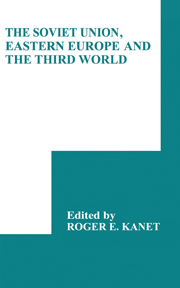Book contents
- Frontmatter
- Contents
- List of figures
- List of tables
- List of contributors
- Foreword by R.C. Elwood
- Preface by Roger E. Kanet
- PART 1 THE THIRD WORLD IN SOVIET FOREIGN POLICY
- 1 The Soviet Union and the Third World from Khrushchev to Gorbachev: the place of the Third World in evolving Soviet global strategy
- 2 Revolutionary change in the Third World: recent Soviet reassessments
- 3 Anti-Soviet insurgencies: growing trend or passing phase?
- 4 The Soviet Union and the New World Information Order
- 5 Soviet propaganda and the process of national liberation
- PART 2 CMEA ECONOMIC INVOLVEMENT IN THE THIRD WORLD
- PART 3 THE SOVIET UNION IN THE MIDDLE EAST AND SOUTH ASIA
- Index
- Publications from the Third World Congress for Soviet and East European Studies, Washington, 1985
3 - Anti-Soviet insurgencies: growing trend or passing phase?
from PART 1 - THE THIRD WORLD IN SOVIET FOREIGN POLICY
Published online by Cambridge University Press: 06 July 2010
- Frontmatter
- Contents
- List of figures
- List of tables
- List of contributors
- Foreword by R.C. Elwood
- Preface by Roger E. Kanet
- PART 1 THE THIRD WORLD IN SOVIET FOREIGN POLICY
- 1 The Soviet Union and the Third World from Khrushchev to Gorbachev: the place of the Third World in evolving Soviet global strategy
- 2 Revolutionary change in the Third World: recent Soviet reassessments
- 3 Anti-Soviet insurgencies: growing trend or passing phase?
- 4 The Soviet Union and the New World Information Order
- 5 Soviet propaganda and the process of national liberation
- PART 2 CMEA ECONOMIC INVOLVEMENT IN THE THIRD WORLD
- PART 3 THE SOVIET UNION IN THE MIDDLE EAST AND SOUTH ASIA
- Index
- Publications from the Third World Congress for Soviet and East European Studies, Washington, 1985
Summary
Since the end of The Second World War there have been a number of insurgencies in which Marxist forces have fought against pro-Western governments. In some cases the Marxists have come to power, as in Vietnam, Cuba, Kampuchea, Laos, Angola, Mozambique, Ethiopia, South Yemen, and Nicaragua. In others the Marxists have been defeated, as in Greece, Malaya, and Oman. But whether they have won or lost, the West has seen itself on the defensive against the Marxists. Since the mid-1970s, though, a new phenomenon has taken place. Pro-Soviet Marxist Third World governments have had to fight armed internal opponents in Afghanistan, Kampuchea, Angola, Mozambique, Ethiopia, and Nicaragua. Further, these Marxist governments have been unable to defeat their opponents even after many years of fighting.
The term “anti-Soviet insurgency” is not really the most accurate description of these conflicts. For the most part, the forces opposing pro-Soviet governments are not primarily motivated by anti-Soviet or even anti-communist concerns, but by local factors. The term “anti-Soviet insurgency” is nevertheless a useful one, for it points out a larger problem faced by Soviet foreign policy. No matter what the cause of each of these insurrections might have been, they demonstrate that the rule of pro-Soviet Marxist–Leninist governments in the Third World is not especially secure. Although none of these pro-Soviet Marxist–Leninist governments has yet been overthrown by guerrilla forces, neither have Marxist governments been able to defeat the guerrillas.
- Type
- Chapter
- Information
- The Soviet Union, Eastern Europe and the Third World , pp. 42 - 69Publisher: Cambridge University PressPrint publication year: 1988

